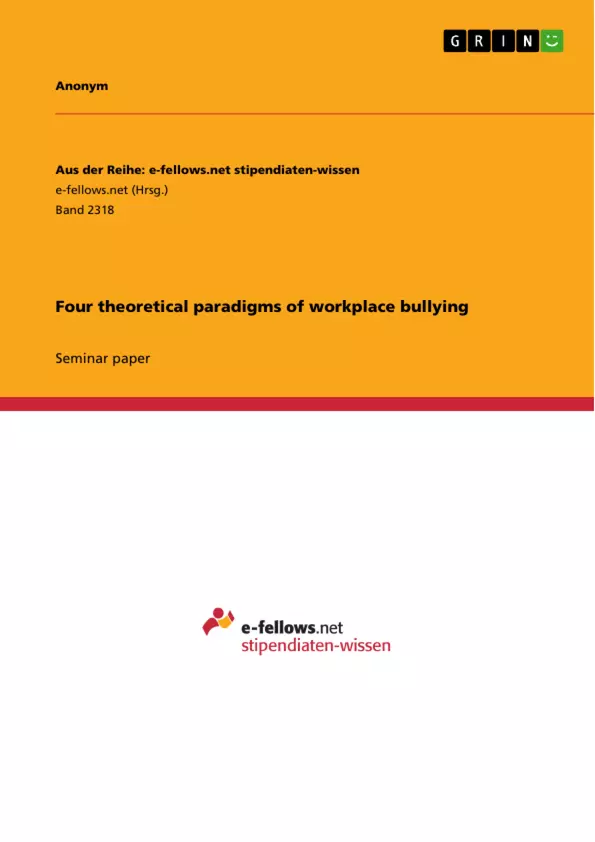In this paper I will discuss the characteristics of the four theoretical paradigms of workplace bullying after Samnani (2013) and make an analysis of their strengths and weaknesses.
According to Bratton and Gold, workplace bullying is defined as a personalized attack from one employee to another employee that takes place on a constant basis for a certain time using emotionally threatening behaviors. As a result the employee's self-esteem, self-confidence and work-competence could be injured. Moreover, the imbalance of power between perpetrator and victim needs to be considered. Workplace bullying needs to be taken as a serious issue since its effects are not only limited to the performance of the people involved but also to the whole organization.
The four theoretical paradigms, as mentioned by Samnani, are: Functionalism, Interpretivism, Critical Management Theory, and Postmodernism. They differ in causes of workplace bullying, philosophical beliefs, and implications.
There are three major areas in workplace bullying literature: One is the mostly qualitative measured prevalence rate of workplace bullying in a country, organization or industry. Secondly there are identifying antecedents of workplace bullying, and last of all the physical, psychological and work-related consequences for the bullying victim of workplace bullying. For brevity’s sake the focus of this reflection paper will be on the antecedents of bullying.
Table of Contents
- Introduction
- Functionalism
- Interpretivism
- Critical Management Theory
- Postmodernism
Objectives and Key Themes
This paper aims to analyze the strengths and weaknesses of four theoretical paradigms of workplace bullying, as defined by Samnani (2013). These paradigms offer diverse perspectives on the causes, implications, and understanding of this phenomenon.
- The influence of different theoretical perspectives on understanding workplace bullying
- Strengths and weaknesses of each paradigm in explaining workplace bullying
- The role of power dynamics and social structures in perpetuating bullying
- The impact of individual characteristics and organizational contexts on workplace bullying
- The importance of considering both objective and subjective perspectives on workplace bullying
Chapter Summaries
- Introduction: This chapter provides a brief overview of workplace bullying and introduces the four theoretical paradigms discussed in the paper: Functionalism, Interpretivism, Critical Management Theory, and Postmodernism. It also highlights the importance of understanding the antecedents of workplace bullying.
- Functionalism: This chapter focuses on the Functionalist paradigm, which emphasizes the objective and systemic nature of workplace bullying. It explores the role of individual personality traits, demographic factors, and leadership styles in contributing to bullying. The chapter also discusses the victim precipitation theory and the use of quantitative and qualitative methods to study workplace bullying.
- Interpretivism: This chapter examines the Interpretivist paradigm, which emphasizes the subjective experiences and interpretations of individuals involved in workplace bullying. It explores the concept of symbolic interactionism and the use of qualitative methods to understand the perspectives of victims and perpetrators. The chapter also highlights the importance of considering the emotional and psychological aspects of bullying.
- Critical Management Theory: This chapter delves into the Critical Management Theory paradigm, which combines elements of radical humanism and radical structuralism to critique power imbalances and social structures that contribute to workplace bullying. It examines the role of bureaucracy, abusive management practices, and the impact of organizational culture on bullying behavior.
Keywords
This paper focuses on workplace bullying, theoretical paradigms, functionalism, interpretivism, critical management theory, postmodernism, antecedents, victim precipitation theory, symbolic interactionism, power dynamics, social structures, organizational culture, and qualitative research methods.
- Quote paper
- Anonym (Author), 2014, Four theoretical paradigms of workplace bullying, Munich, GRIN Verlag, https://www.grin.com/document/364505



